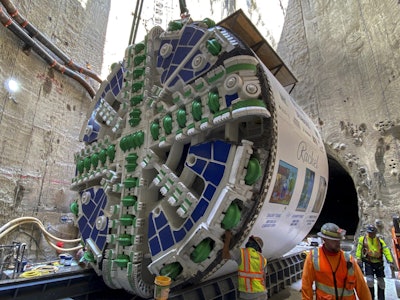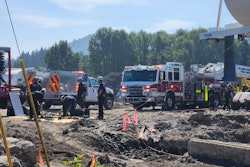
- All 31 construction workers escaped without serious injury after a partial tunnel collapse at the Los Angeles Effluent Outfall Tunnel Project on July 9.
- A massive pile of soil and debris collapsed into the tunnel, prompting a full investigation by the L.A. County Sanitation District into the safety and structural integrity of the Clearwater Project.
- The $630.5 million project, designed to modernize wastewater infrastructure, is now halted indefinitely.
Thirty-one construction workers escaped uninjured from a partial collapse at a massive tunnel project in Los Angeles, according to the Los Angeles Fire Department.
The Fire Department got a report at about 8 p.m. July 9 that workers were stranded at the Los Angeles Effluent Outfall Tunnel Project, designed to be a 7-mile, 18-foot-diameter tunnel for treated wastewater, in the Wilmington neighborhood.
According to the department, all the stranded workers scrambled to safety one at a time across a large section of piled soil and debris, helped by coworkers, before LAFD rescuers arrived. “Colleagues then ferried them more than five miles in a tunnel transport vehicle to the safety of the access portal,” LAFD says. “A total of 31 uninjured workers from throughout the tunnel system were brought to safety by their colleagues.”
None of the workers had visible injuries or any medical complaints, the department said. They were examined by LAFD paramedics and released at the scene. News reports indicate 27 workers were trapped, and four workers entered after the collapse to help rescue them. The L.A. County Sanitation District said some workers were treated on the scene for minor injuries. The district said LAFD and rescue crews assisted construction workers with rescue operations.
The partial collapse of the tunnel brought down “a 12- to 15-foot-tall pile of loose soil and debris into a large but undetermined length of the solitary passageway,” the fire department reports.
The Clearwater Project, in which the workers were involved, includes the tunnel’s construction to replace aging structures. The Los Angeles County Sanitation District said a portion of the tunnel collapsed near the five-mile mark.
“We are working directly with the contractors to conduct a full investigation of the cause of this incident," the district said in a statement July 10. "The investigation will look at the safety, engineering and structural integrity of the tunnel and has already begun. Clearwater Tunnel operations have been halted while this investigation takes place, and there is no timeframe for how long the process will take.”
The Los Angeles Effluent Outfall Tunnel project was commissioned by the county Sanitation District and awarded to Flatiron Dragados as a $630.5 million contract in 2019.
Flatiron Dragados issued the following to statement to Equipment World on July 10:
"FlatironDragados wants to thank the teams of Los Angeles first responders for their fast and comprehensive response to this incident. We also want to recognize the professionalism of our highly skilled employees who knew exactly what to do in this situation. Fortunately, the workers involved made their way out of the tunnel safely and uninjured. Emergency preparedness is essential on all of our construction projects. Work at the project has been suspended while we investigate this incident."
Work on the main shaft construction began in January 2020, and tunnel boring began in January 2022. German tunnel boring machine manufacturer Herrenknecht delivered the TBM – named "Rachel" – for the project. Rachel is 21.5 feet tall, over 900 feet long and tunnels 40 to 50 feet per day, stopping every 5 feet to put up prefabricated tunnel wall segments. TBM Rachel in use in Los Angeles circa 2022South Bay Cities Council of Governments
TBM Rachel in use in Los Angeles circa 2022South Bay Cities Council of Governments
Aiming to improve wastewater management and protect local waterways, the completed tunnel will transport effluent from the Hyperion Water Reclamation Plant to the Pacific Ocean.
The upgrade is designed to address aging infrastructure, seismic activity along local earthquake faults and overflow risks during heavy rains. Severe rainstorms in January 2024 pushed the system to near capacity. Tunneling was estimated to be completed in 2027.













